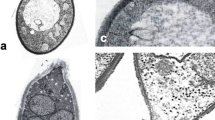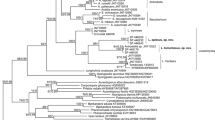Abstract
The basidiomycetous yeast genusErythrobasidium Hamamoto, Sugiyama & Komagata, based on the type speciesE. hasegawianum Hamamoto et al., is characterized by filobasidiaceous basidia and the Q-10 (H2) system as its major ubiquinone. It is tentatively placed in the Filobasidiaceae. The molecular characterization is based on 18S ribosomal RNA sequence comparisons among the basidiomycetous yeasts, and the ultrastructural characterization on the cell wall and hyphal septal pores inE. hasegawianum clearly indicate a close relationship with the teliospore-forming yeastsRhodosporidium toruloides andLeucosporidium scottii. Our molecular phylogeny with statistical analysis suggests that the existing taxonomic system of basidiomycetous yeasts, based primarily on the morphology of basidia including the teliospores (probasidia), should be revised.
Similar content being viewed by others
References
Banno I (1967) Studies on the sexuality ofRhodotorula. J. Gen. Appl. Microbiol. 13: 167–196
Barnett JA, Payne RW & Yarrow D (1990) Yeasts: Characteristics and identification. Cambridge University Press, Cambridge
Berbee ML & Taylor JW (1992a) Two ascomycete classes based on fruiting-body characters and ribosomal RNA sequence. Mol. Biol. Evol. 9: 278–284
—— (1992b) Convergence in ascospore discharge mechanism among pyrenomycete fungi based on 18S ribosomal RNA gene sequence. Mol. Phylogenet. Evol. 1: 59–71
Blanz PA & Unseld M (1987) Ribosomal RNA as a taxonomic tool in mycology. In: de Hoog GS, Smith MTh & Weijman ACM (Eds) The Expanding Realm of Yeast-like Fungi (pp247–258) Elsevier Science Publishers, Amsterdam
Bruns TD, White TJ & Taylor JW (1991) Fungal molecular systematics. Annu. Rev. Ecol. Syst. 22: 525–564
Bowman BH, Taylor JW, Brownlee AG, Lee J, Lu S-D & White TH (1992) Molecular evolution of the fungi: relationship of the Basidiomycetes, Ascomycetes, and Chytridiomycetes. Mol. Biol. Evol. 9: 285–296
Cox DE (1976) A new homobasidiomycete with anomalous basidia. Mycologia 68: 481–510
De Wachter R, Neefs JM, Goris A & van de Peer Y (1992) The gene coding for small ribosomal subunit RNA in the basidiomyceteUstilago maydis contains a group 1 intron. Nucleic Acids Res. 20: 1251–1257
Fell JW & Kurtzman CP (1990) Nucleotide sequence analysis of a variable region of the large subunit rRNA for identification of marine-occurring yeasts. Curr. Microbiol. 21: 295–300
Fell JW, Statzell AC, Hunter IL & Phaff HJ (1969)Leucosporidium gen. n., the heterobasidiomycetous stage of several species of the genusCandida. Antonie van Leeuwenhoek 35: 433–462
Fell JW, Statzell-Tallman AC, Lutz MJ & Kurtzman CP (1992) Partial rRNA sequences in marine yeasts: a model for identification of marine eukaryotes. Mol. Mar. Biol. Biotechnol. 1: 175–186
Felsenstein J (1985) Confidence limits on phylogenies: an approach using the bootstrap. Evolution 39: 783–791
Förster H, Coffey MD, Elwood H & Sogin ML (1990) Sequence analysis of the small subunit ribosomal RNAs of three zoosporic fungi and implications for fungal evolution. Mycologia 82: 306–312
Geber A, Higgins DE, Waters AP, Bennet JE & McCutchan TF (1992) Small subunit ribosomal RNA ofBlastomyces dermatitidis: sequence and phylogenetic analysis. J. Gen. Microbiol. 138: 395–399
Guého E, Kurtzman CP & Peterson SW (1989) Evolutionary affinities of heterobasidiomycetous yeasts estimated from 18S and 25S ribosomal RNA sequence divergence. System. Appl. Microbiol. 12: 230–236
Goto S, Sugiyama J, Hamamoto M & Komagata K (1987)Saitoella, a new anamorphic genus in the Cryptococcaceae to accommodate two Himalayan yeast isolates formerly identified asRhodotorula glutinis. J. Gen. Appl. Microbiol. 33: 75–85
Hamamoto M, Sugiyama J & Komagata K (1988a) Transfer ofRhodosporidium infirmominiatum to the genusCystofilobasidium asCystofilobasidium infirmominiatum comb. nov. J. Gen. Appl. Microbiol. 34: 271–278
—— (1988b) Transfer ofRhodotorula hasegawae to a new basidiomycetous genusErythrobasidium asErythrobasidium hasegawae comb. nov. J. Gen. Appl. Microbiol. 34: 279–287
—— (1991) Nomenclature of the basidiomycetous yeast speciesErythrobasidium hasegawae. J. Gen. Appl. Microbiol. 37: 131–132
Hendriks L, Goris A, Neefs J-M, van de Peer Y, Neefs J, Hennebert G & de Wachter R (1989) The nucleotide sequence of the small ribosomal subunit RNA of the yeastCandida albicans and the evolutionary position of the fungi among the eukaryotes. System. Appl. Microbiol. 12: 223–229
Hendriks L, de Baere R, van de Peer Y, Neefs J, Goris A & de Wachter R (1991) The evolutionary position of the rhodophytePorphyra umbilicalis and the basidiomyceteLeucosporidium scottii among other eukaryotes as deduced from complete sequences of small ribosomal subunit RNA. J. Mol. Evol. 32: 167–177
Hibbett DA (1992) Ribosomal RNA and fungal systematics. Trans. Mycol. Soc. Japan 33: 533–556
Illingworth CA, Andrews JH, Bibeau C & Sogin ML (1991) Phylogenetic placement ofAthelia bombacina, Aureobasidium pullulans, andColletotrichuim gloeosporioides inferred from sequence comparisons of small-subunit ribosomal RNAs. Exp. Mycol. 15: 65–75
Ina Y (1991) ODEN: Molecular Evolutionary Analysis System for DNA and Amino Acid Sequences, Version 1.1. DNA Research Center, National Institute of Genetics, Mishima, Japan
Johnson-Reid JA & Moore RT (1972) Some ultrastructural features ofRhodosporidium toruloides Banno. Antonie van Leeuwenhoek 38: 417–435
Kimura M (1980) A simple method for estimating evolutionary rate of base substitutions through comparative studies of nucleotide sequences. J. Mol. Evol. 16: 111–120
Kohn LM (1992) Developing new characters for fungal systematics: an experimental approach for determining the rank of resolution. Mycologia 84: 139–153
Kraepelin G & Schulze U (1982)Sterigmatosporidium gen. n., a new heterothallic basidiomycetous yeast, the perfect state of a new species ofSterigmatomyces. Antonie van Leeuwenhoek 48: 471–483
Kreger-van Rij NJW (1984) Chapter 1. General classification of the yeasts. In: Kreger-van Rij NJW (Ed) The Yeasts, a Taxonomic Study (pp1–44) Elsevier Science Publishers, Amsterdam
—— (1987) Classification of yeasts. In: Rose AH & Harrison JS (Eds) The Yeasts, 2nd Ed., Vol. 1 (pp5–61) Academic Press, London
Kurtzman CP (1992) rRNA sequence comparisons for assessing phylogenetic relationships among yeasts. Int. J. Syst. Bacteriol. 42: 1–6
Kwon-Chung KJ (1975) A new genus,Filobasidiella, the perfect state ofCryptococcus neoformans. Mycologia 67: 1197–1200
—— (1987) Filobasidiaceae — a taxonomic survey. In: de Hoog GS et al. (Eds) The Expanding Realm of Yeast-like Fungi (pp75–85) Elsevier Science Publishers, Amsterdam
Maleszka R & Clark-Walker GD (1990) Sequence of the gene for the cytoplasmic ribosomal RNA small subunit fromKluyveromyces lactis. Nucleic Acids Res. 18: 1889
Mankin AS, Skryabin KG & Rubstov PM (1986) Identification of ten additional nucleotides in the primary structure of yeast 18S rRNA. Gene 44: 143–145
McCully EK & Robinow CF (1972a) Mitosis in heterobasidiomycetous yeasts. I.Leucosporidium scottii (Candida scottii). J. Cell Sci. 10: 857–881
—— (1972b) Mitosis in heterobasidiomycetous yeasts. II.Rhodosporidium sp. (Rhodotorula glutinis) andAessosporon salmonicolor (Sporobolomyces salmonicolor). J. Cell Sci. 11: 1–31
Moore RT (1972) Ustomycota, a new division of higher fungi. Antonie van Leeuwenhoek 38: 567–584
Moore RT & Kreger-van Rij NJW (1972) Ultrastructure ofFilobasidium Olive. Can. J. Microbiol. 18: 1949–1951
Nakase T & Suzuki M (1986) The ubiquinone system in strains of species in the ballistospore-forming yeast generaSporidiobolus, Sporobolomyces andBullera. J. Gen. Appl. Microbiol. 32: 251–258
Nishida H & Sugiyama J (1993) Phylogenetic relationships amongTaphrina, Saitoella, and other higher fungi. Mol. Biol. Evol. 10: 431–436
Nyland G (1949) Studies on some unusual Heterobasidiomycetes from Washington State. Mycologia 41: 686–701
Oberwinkler F & Bandoni RJ (1982) A taxonomic survey of the gasteroid, auricularioid Heterobasidiomycetes. Can. J. Bot. 60: 1726–1750
Oberwinkler F, Bandoni R, Blanz P & Kisimova-Horovitz L (1983)Cystofilobasidium: a new genus in the Filobasidiaceae. System. Appl. Microbiol. 4: 114–122
Olive LS (1968) An usual new heterobasidiomycete withTilletia-like basidia. J. Elisha Mitchell Sci. Soc. 84: 261–266
Rodrigues de Miranda L (1972)Filobasidium capsuligenum nov. comb. Antonie van Leeuwenhoek 38: 91–99
Saitou N & Nei M (1987) The neighbor-joining method: a new method for reconstructing phylogenetic trees. Mol. Biol. Evol. 4: 406–425
Shivas RG & Rodrigues de Miranda L (1983) Two new species of the genusSporobolomyces and a newRhodotorula species from leaf surfaces. Antonie van Leeuwenhoek 49: 159–166
Sogin ML, Miotto K & Miller L (1986) Primary structure of theNeurospora crassa small subunit ribosomal RNA coding region. Nucleic Acids Res. 14: 9540
Suh S-O, Hirata A, Sugiyama J & Komagata K (1993a) Septal ultra-structure of basidiomycetous yeasts and their taxonomic implications with observations on the ultrastructure ofErythrobasidium hasegawianum andSympodiomycopsis paphiopedili. Mycologia 85 (1): 30–37
Suh S-O & Sugiyama J (1993b) Phylogeny among the basidiomycetous yeasts inferred from small subunit ribosomal DNA sequence. J. Gen. Microbiol. (in press)
-- (1993c) Septal pore ultrastructure ofLeucosporidium larimarini, a basidiomycetous yeast, and its taxonomic implications. J. Gen. Appl. Microbiol. 39 (in press)
Yamada Y & Banno I (1984)Fellomyces, a new anamorphic yeast genus for the Q10-equipped organisms whose conidium is freed by an end-break in the sterigma. J. Gen. Appl. Microbiol. 30: 523–525
Yamada Y & Kondo K (1973) Coenzyme Q system in the classification of the yeast generaRhodotorula andCryptococcus, and the yeast-like generaSporobolomyces andRhodosporidium. J. Gen. Appl. Microbiol. 19: 59–77
Yamada Y, Kanematsu M, Ohashi M & Kondo K (1973) On the partly reduced coenzyme Q isolated from ‘Rhodotorula lactosa’ IFO 1058 and its relation to the taxonomic position. Agric. Biol. Chem. 37: 621–628
Yamada Y & Komagata K (1983)Rhodotorula hasegawae sp. nov., a new asporogenous yeast species. J. Gen. Appl. Microbiol. 29: 323–326
Yamada Y, Nakagawa Y & Banno I (1989) The phylogenetic relationships of the Q9-equipped species of the heterobasidiomycetous yeast generaRhodosporidium andLeucosporidium based on 18S and 26S ribosomal ribonucleic acids: The proposal of a new genusKondoa. J. Gen. Appl. Microbiol. 35: 377–385
—— (1990) The molecular phylogeny of the Q10-equipped species of the heterobasidiomycetous yeast genusRhodosporidium Banno based on the partial sequences of 18S and 26S ribosomal ribonucleic acids. J. Gen. Appl. Microbiol. 36: 435–444 (1990)
Author information
Authors and Affiliations
Rights and permissions
About this article
Cite this article
Sugiyama, J., Suh, SO. Phylogenetic analysis of basidiomycetous yeasts by means of 18S ribosomal RNA sequences: relationship ofErythrobasidium hasegawianum and other basidiomycetous yeast taxa. Antonie van Leeuwenhoek 63, 201–209 (1993). https://doi.org/10.1007/BF00872394
Received:
Accepted:
Issue Date:
DOI: https://doi.org/10.1007/BF00872394




